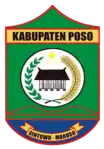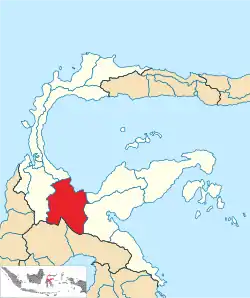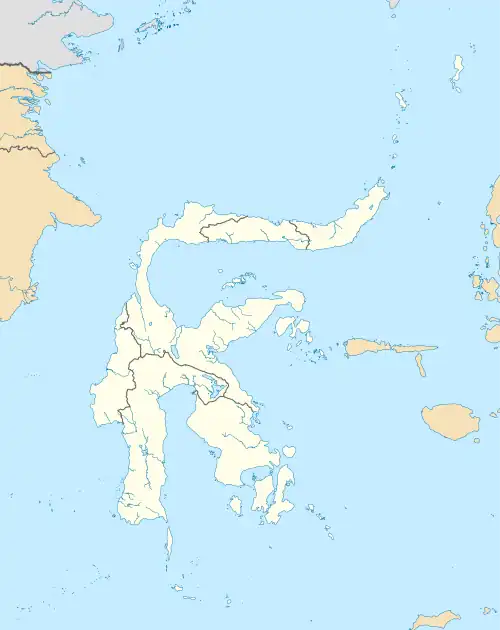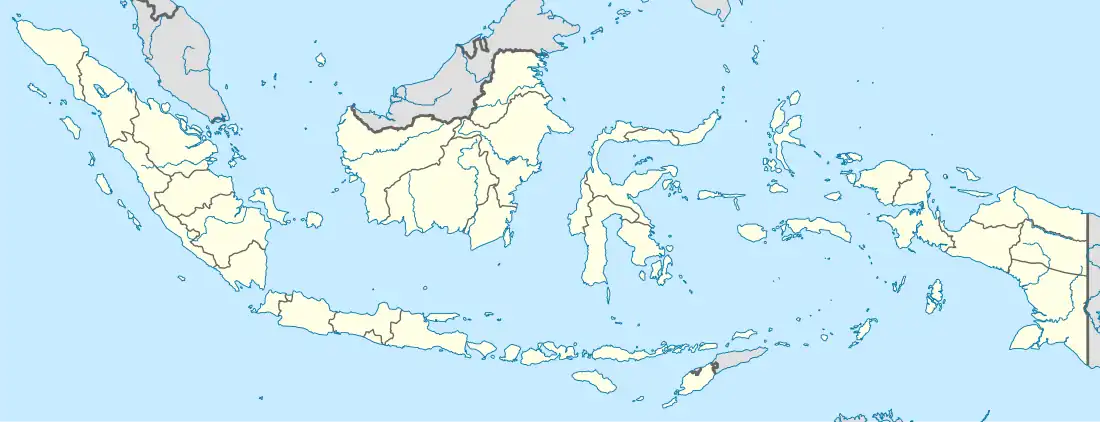Poso Regency
Kabupaten Poso | |
|---|---|
 Coat of arms | |
| Motto(s): Sintuwu Maroso (Strong Brotherly Ties) | |
 Location within Central Sulawesi | |
| Coordinates: 1°22′59″S 120°44′55″E / 1.38306°S 120.74861°E | |
| Country | Indonesia |
| Province | Central Sulawesi |
| Capital | Poso |
| Government | |
| • Regent | Verna Inkiriwang |
| • Vice Regent | Yasin Mangun |
| Area | |
| • Total | 7,112.25 km2 (2,746.06 sq mi) |
| Population (mid 2022 estimate)[1] | |
| • Total | 252,650 |
| • Density | 36/km2 (92/sq mi) |
| Time zone | UTC+8 (ICST) |
| Area code | (+62) 452 |
| Website | posokab.go.id |
Poso Regency is a regency of Central Sulawesi Province of Indonesia. It covers an area of 7,112.25 km2, and had a population of 209,228 at the 2010 Census[2] and 244,875 at the 2020 Census;[3] the official estimate as at mid 2022 was 252,650 (comprising 130,294 males and 122,356 females).[1] The principal town lies at Poso.
History
In 1999, Morowali Regency and Tojo Una-Una Regency were created out of eastern portions of Poso Regency. In 2007 there were calls to divide the remaining Poso Regency into two regencies to overcome religious-based conflicts; one new regency in the southeastern and western sectors would by named Tentena Regency (comprising the first twelve kecamatan listed below), while the residual Poso Regency in the northeast sector (bordering the Gulf of Tomini) would consist of the last seven kecamatan listed below[4]
Administrative districts
At the time of the 2010 Census, the Poso Regency was divided at 2010 into eighteen districts (kecamatan), but an additional 19th district (Pamona Pusalemba) was subsequently added by splitting off the western and southern villages of Pamona Utara District.[5] The districts are tabulated below with their areas and their populations at the 2010 Census[2] and the 2020 Census,[3] together with the official estimates as at mid 2022.[1] The table also includes the locations of the district administrative centres, the numbers of villages in each district (totalling 142 rural desa and 28 urban kelurahan), and its postal code.
| Kode Wilayah | Name of District (kecamatan) | Area in km2 | Pop'n Census 2010 | Pop'n Census 2020 | Pop'n estimate mid 2022 | Admin centre | No. of villages | Post code |
|---|---|---|---|---|---|---|---|---|
| 72.02.06 | Pamona Selatan (South Pamona) | 474.65 | 18,372 | 20,977 | 21,539 | Pendolo | 12 | 94664 |
| 72.02.20 | Pamona Barat (West Pamona) | 174.91 | 9,344 | 10,214 | 10,400 | Meko | 6 | 94662 |
| 72.02.26 | Pamona Tenggara (Southeast Pamona) | 227.17 | 6,487 | 7,888 | 8,199 | Korobono | 9 | 94665 |
| 72.02.27 | Pamona Utara (North Pamona) | 422.04 | 30,191 | 14,628 | 12,896 | Sulewana | 10 (a) | 94667 |
| 72.02.04 | Pamona Pusalemba | 367.54 | (a) | 19,357 | 19,652 | Tentena | 11 (a) | 94663 |
| 72.02.05 | Pamona Timur (East Pamona) | 549.38 | 9,531 | 12,271 | 15,158 | Taripa | 13 | 94666 |
| Southeast Sector | 2,215.69 | 73,925 | 85,335 | 87,844 | 61 | |||
| 72.02.09 | Lore Selatan (South Lore) | 771.59 | 5,631 | 6,774 | 7,026 | Gintu | 8 | 94655 |
| 72.02.23 | Lore Barat (West Lore) | 331.36 | 2,821 | 3,188 | 3,267 | Lengkeka | 6 | 94654 |
| 72.02.07 | Lore Utara (North Lore) | 466.75 | 11,902 | 15,659 | 16,400 | Wuasa | 7 | 94658 |
| 72.02.08 | Lore Tengah (Central Lore) | 657.06 | 4,033 | 4,971 | 5,180 | Doda | 8 | 94656 |
| 72.02.24 | Lore Timur (East Lore) | 112.40 | 4,877 | 6,690 | 6,953 | Maholo | 5 | 94657 |
| 72.02.25 | Lore Peore | 525.20 | 2,944 | 4,015 | 4,164 | Watutau | 5 | 94653 |
| Western Sector | 2,864.36 | 32,208 | 41,297 | 42,989 | 39 | |||
| 72.02.02 | Poso Pesisir (Coastal Poso) | 307.66 | 20,098 | 22,285 | 22,753 | Mapane | 16 (a) | 94652 |
| 72.02.19 | Poso Pesisir Selatan (South Coastal Poso) | 609.39 | 8,842 | 9,910 | 10,139 | Tangkura | 9 | 94650 |
| 72.02.18 | Poso Pesisir Utara (North Coastal Poso) | 558.34 | 15,681 | 17,427 | 17,801 | Tambarawa | 10 | 94651 |
| 72.02.01 | Poso Kota (Poso Town) | 11.29 | 20,250 | 24,145 | 25,288 | Gebang Rejo | 7 (b) | 94617 - 94619 |
| 72.02.21 | Poso Kota Selatan (South Poso Town) | 25.06 | 8,992 | 10,402 | 10,708 | Kawua | 5 (b) | 94613 - 94619 |
| 72.02.22 | Poso Kota Utara (North Poso Town) | 20.22 | 11,058 | 12,930 | 13,338 | Lawanga | 7 (b) | 94611 - 94616 |
| 72.02.03 | Lage | 498.24 | 18,174 | 21,144 | 21,790 | Tagolu | 16 | 94661 |
| Northeast Sector | 2,030.20 | 103,095 | 118,243 | 121,817 | 70 |
Notes: (a) including 3 urban kelurahan. (b) all classed as urban kelurahan.
Social
Religions
Poso District Religious Office noted that the majority of the population in Poso is Protestant, with the number of adherents as many as 122,389 inhabitants. This is followed by 95,417 Muslims, 9,739 Hindus, 1,425 Roman Catholics and 267 Buddhists, respectively. The number of places of worship in Poso, consisting of 270 mosques, 500 Protestant churches, 36 Catholic churches and 71 temples.[6]
Islam is the first religion which spread widely in Poso. Although the process is not known, Islam certainly been entered in Poso around the end of the 18th century. The migration of Mandar tribe of western Sulawesi region also proved influential in this process. This process culminated in the events in which Mandar people living in the area of Kadombuku (now Lage), forcing the local tribal people to convert to Islam (the local tribe who converted to Islam are now known as the Poso Pesisir people) and end up with a series of tribal wars between Mandar and Kadombuku.[7][8] Christianity began to spread in the late 19th century, when a Dutch missionary, Albert Christian Kruyt sent by a Christian mission agency of the Netherlands Missionary Society to begin missionary in Central Sulawesi. After working for seventeen years, their efforts paid off when hundreds of people from To Pebato baptized on Christmas Eve, 25 December 1909.[9] Central Sulawesi Christian Church (GKST) is a church organization that was established on 18 October 1947 in Tentena.[10] GKST serves Central, West and South Sulawesi. In 2006, 188 thousand people registered to become members, and there are 376 congregations served by 625 priests.[11]
Tourism
Tambing Lake is located in Lore Lindu National Park, 3 hours drive from Palu and 100 meters away from Palu-Napu Road. In 2014, there are 3,000 foreign tourists visited Tambing Lake which is known as Endemic Bird Paradise with 30 percent of 270 kinds of birds are endemic.[12]
Ecology
.JPG.webp)
Sulawesi black Ebony, also known as diospyros celebica, naturally can be found in Central Sulawesi (Parigi, Poso, Donggala), South Sulawesi (Maros), West Sulawesi (Mamuju) and Maluku. The International Union for Conservation of Nature (IUCN) has issued their red list in 2000 and D. celebica belong to the category of vulnerable species, which means that ebony is at the limit of high risk for extinction in the wild (vulnerable to exploitation).[13]
Most of the endemic fauna in Poso is located in the area of cultural and natural heritage, such as Lake Poso and Lore Lindu National Park. Whitten (1987), Maurice Kottelat, and L.R. Parenti states that there are several species of endemic biota that is only found in Lake Poso, such as Xenopoecilus poptae (Adrianichthys poptae); Adrianichthys kruyti, Weberogobius amadi and Nomorhamphus celebensis. Other endemic fish is Anguilla celebensis, Xenopoecilus sarasinorum, Xenopoecilus oophorus (adrianichthys oophorus), Adrianichthys roseni; gastropods such as Miratesta celebensis; and some small shrimp (Caridina sp).
References
- 1 2 3 Badan Pusat Statistik, Jakarta, 2023, Kabupaten Poso Dalam Angka 2023 (Katalog-BPS 1102001.7202)
- 1 2 Biro Pusat Statistik, Jakarta, 2011.
- 1 2 Badan Pusat Statistik, Jakarta, 2021.
- ↑ Sangadji, Ruslan (21 February 2007). "Residents say a divided Poso could be a more peaceful place". The Jakarta Post. Archived from the original on 5 May 2013. Retrieved 5 May 2013.
- ↑ "Perda No 11 Thn 2010 ttg Pemb Kec Pamona Utara" [Regional Regulation No. 11 of 2010 concerning Pemb Pemb Pamona Utara District] (PDF). 2010. p. 4.
- 1 2 Badan Pusat Statistik 2016a, p. 76.
- ↑ Adriani & Kruyt 1912, p. 42.
- ↑ Kaudern 1925b, p. 112.
- ↑ Tampake 2009, p. 1.
- ↑ Fasse, Cristoph. "Address data base of Reformed churches and institutions". Reformiert Online. Retrieved 27 February 2017.
- ↑ "Christian Church of Central Sulawesi — World Council of Churches". Oikoumene.org. January 1948. Retrieved 27 February 2017.
- ↑ "Danau Tambing Kembali Ramai Dikunjungi Wisatawan". 25 April 2015.
- ↑ "Eboni, si Kayu Hitam dari Sulawesi". Universitas Atma Jaya Yogyakarta (in Indonesian). Archived from the original on 29 October 2015. Retrieved 31 October 2016.
Bibliography
- Abubakar, Jamrin (2015). 15 Tokoh Bersejarah Provinsi Sulawesi Tengah. Palu: Dinas Pendidikan dan Kebudayaan Daerah Sulawesi Tengah. ISBN 978-602-1158-09-8.
- Adriani, Nicolaus (1919). Posso (Midden-Celebes). The Hague: Zendingsstudie-Raad.
- Adriani, Nicolaus; Kruyt, Albertus Christiaan (1912). De Bare'e sprekende Toradja's van Midden-Celebes. Batavia: Landsdrukkerij.
- Henley, David (2005). Fertility, Food and Fever: Population, Economy and Environment in North and Central Sulawesi, 1600–1930. Leiden: KITLV Press. ISBN 906-7182-09-5.
- Kaudern, Walter (1925a). Ethnographical studies in Celebes: results of the author's expedition to Celebes, 1917–1920 – Structures and settlements in Central Celebes. Vol. 1. Göteborg: Elanders Boktryckeri Aktiebolag.
- Kaudern, Walter (1925b). Results of the author's expedition to Celebes, 1917–1920: Migrations of the Toradja in Central Celebes. Vol. 2. The Hague.
{{cite book}}: CS1 maint: location missing publisher (link) - Kaudern, Walter (1927). Results of the author's expedition to Celebes, 1917–1920: Musical Instruments in Celebes. Vol. 3. Göteborg: Elanders Boktryckeri Aktiebolag.
- Kaudern, Walter (1929). Ethnographical studies in Celebes: results of the author's expedition to Celebes, 1917–1920 – Games and Dances in Celebes. Vol. 4. Göteborg: Elanders Boktryckeri.
- Kaudern, Walter (1938). Ethnographical studies in Celebes: results of the author's expedition to Celebes, 1917–1920 – Megalithic Finds in Central Celebes. Vol. 5. Göteborg: Elanders Boktryckeri Aktiebolag.
- Kahn, Joel S. (1998). Southeast Asian Identities: Culture and the Politics of Representation in Indonesia, Malaysia, Singapore, and Thailand. Singapura: I.B.Tauris. ISBN 1-86064-243-8.
- Kruyt, Albertus Christiaan (2008). Keluar dari Agama Suku, Masuk ke Agama Kristen. Jakarta: BPK Gunung Mulia. ISBN 978-979-6873-37-1.
- Kutoyo, Sutrisno (2005). Sejarah Daerah Sulawesi Tengah. Jakarta: Dinas Kebudayaan dan Pariwisata Sulawesi Tengah.
- Mahid, Syakir; Sadi, Haliadi; Darsono, Wilman (2012). Sejarah Kerajaan Bungku. Yogyakarta: Penerbit Ombak. ISBN 978-602-7544-09-3.
- Raven, H.C. (1926). The Stone Images and Vats of Central Celebes. New York City: Museum Nasional Sejarah Amerika.
- Sadi, Haliadi; Mahid, Syakir; Ibrahim, M. Anas (2007). Gerakan pemuda Sulawesi Tengah (GPST) di Poso, 1957–1963: perjuangan anti Permesta dan pembentukan Provinsi Sulawesi Tengah. Yogyakarta: Penerbit Ombak. ISBN 978-979-3472-70-6.
- Sarasin, Paul; Sarasin, Fritz (1905). Reisen in Celebes. Wiesbaden: Kreidel.
Further reading
- Abubakar, Jamrin (2015). 15 Tokoh Bersejarah Provinsi Sulawesi Tengah. Palu: Dinas Pendidikan dan Kebudayaan Daerah Sulawesi Tengah. ISBN 978-602-1158-09-8.
- Aragon, Lorraine Victory (2005). "Mass Media Fragmentation and Narratives of Violent Action in Sulawesi's Poso Conflict". Indonesia (79).
- Badan Pusat Statistik (2016a). Kabupaten Poso dalam Angka 2016 (PDF). Poso: Badan Pusat Statistik Kabupaten Poso. Archived from the original (PDF) on 28 August 2016.
- Badan Pusat Statistik (2016b). Indikator Ekonomi Kabupaten Poso 2015–2016 (PDF). Poso: Badan Pusat Statistik Kabupaten Poso. Archived from the original (PDF) on 1 April 2017.
- Badan Pusat Statistik (2015). Kabupaten Poso dalam Angka 2015 (PDF). Poso: Badan Pusat Statistik Kabupaten Poso.
- Brown, Graham; Tajima, Yukhi; Hadi, Suprayoga (2005). "Overcoming Violent Conflict: Peace and Development Analysis in Central Sulawesi". Indonesia. Jakarta: United Nations Development Programme. 3. ISBN 979-9987-84-9.
- Human Rights Watch (2002). "BREAKDOWN: Four Years of Communal Violence in Central Sulawesi". Indonesia. New York City. 14 (9).
- Weber, Robert; Kreisel, Werner; Faust, Heiko (2003). "Colonial Interventions on the Cultural Landscape of Central Sulawesi by "Ethical Policy": The Impact of the Dutch Rule in Palu and Kulawi Valley, 1905–1942". Leiden: University of Göttingen.
{{cite journal}}: Cite journal requires|journal=(help)

